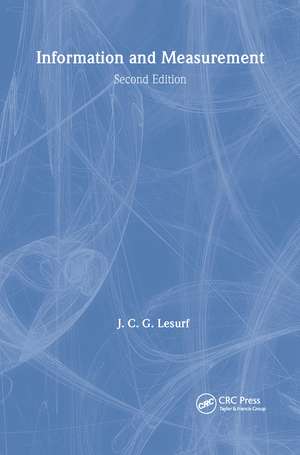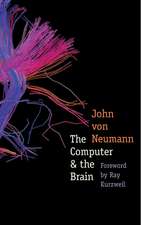Information and Measurement: Series in Measurement Science and Technology
Autor J.C.G Lesurfen Limba Engleză Paperback – 31 oct 2001
This book will be an invaluable study aid for senior undergraduate and graduate students in physics, electrical engineering, and computer science, specifically studying instrumentation, measurement science, and information science. It will also be a useful reference for practicing scientists and engineers.
| Toate formatele și edițiile | Preț | Express |
|---|---|---|
| Paperback (1) | 626.65 lei 43-57 zile | |
| CRC Press – 31 oct 2001 | 626.65 lei 43-57 zile | |
| Hardback (1) | 852.72 lei 43-57 zile | |
| CRC Press – 13 sep 2023 | 852.72 lei 43-57 zile |
Preț: 626.65 lei
Preț vechi: 839.96 lei
-25% Nou
Puncte Express: 940
Preț estimativ în valută:
119.91€ • 125.51$ • 99.80£
119.91€ • 125.51$ • 99.80£
Carte tipărită la comandă
Livrare economică 31 martie-14 aprilie
Preluare comenzi: 021 569.72.76
Specificații
ISBN-13: 9780750308236
ISBN-10: 0750308230
Pagini: 310
Dimensiuni: 156 x 234 x 18 mm
Greutate: 0.54 kg
Ediția:Revised
Editura: CRC Press
Colecția CRC Press
Seria Series in Measurement Science and Technology
ISBN-10: 0750308230
Pagini: 310
Dimensiuni: 156 x 234 x 18 mm
Greutate: 0.54 kg
Ediția:Revised
Editura: CRC Press
Colecția CRC Press
Seria Series in Measurement Science and Technology
Public țintă
UndergraduateCuprins
PrefaceChapter 1 - Where does information come from?1.1Introduction1.2What is information?1.3Accuracy and resolutionChapter 2 - Signals and messages2.1Sending information2.2How much information in a message?Chapter 3 - Noise3.1The sources of noise3.2Johnson noise3.3Shot noise3.4An alternative way to describe noise3.5Other sorts of noiseChapter 4 - Uncertain measurements4.1Doubtful information and errorsChapter 5 - Surprises and redundancyChapter 6 - Detecting and correcting mistakes6.1Errors and the law!6.2Pa1ity and blocks6.3Choosing a code systemChapter 7 - The sampling theorem7.1Fourier transforms and signals of finite length7.2The sampling theorem and signal reconstruction Chapter 8 -The information carrying capacity of a channel8.1Signals look like noise!8.2Shannon's equation8.3Choosing an efficient transmission system8.4Noise, quantisation, and ditherChapter 9 - The CD player as an information channel9.1The CD as an information channel9.2The CD encoding processChapter 10 - The CD player as a measurement systemChapter 11 - Oversampling, noise shaping, and digital filtering11.1The CD player as a digital signal processing systemChapter 12 - Analog or digital?12.1Is the world 'analog'?12.2The 'digital' defects of the long playing recordChapter 13 - Sensors and amplifiers13.1Basic properties of sensors13.2Amplifier noise13.3Specifying amplifier noiseChapter 14-Power coupling and optimum S/N14.1Optimising signal/noise ratio14.2Behaviour of cascaded amplifiers and transmission linesChapter 15 - Signal averaging15.1Measuring signals in the presence of noise15.2The problems of simple averagingChapter 16 - Phase sensitive detectionChapter 17 - Synchronous integration17.1'Boxcar' detection systems17.2Multiplexed and digital systems Chapter 18 - Data compression18.1Run-length encoding18.2Huffman codingChapter 19-Data thinning19.1The discrete cosine transform19.2JPEG compression19.3ATRAC audio compressionChapter 20-Chaos rules!20.1Driven nonlinear systems and bifurcations20.2Chaotic oscillators20.3Noise generatorsChapter 21 - Spies and secret messages21.1Substitution codes21.2One time pads21.3Mechanical 'randomising' algorithms21.4Electronic encryptionChapter 22 - One bit more22.1Problems with many bits22.2One bit at a time22.3From many to one22.4First order delta-sigma conversion22.5One last bit of chaos!Chapter 23 - What have we here?23.1Distinguishing messages23.2Correlation23.3The effects of noise23.4Signal recognition using correlationChapter 24 - Time and frequency24.1The meaning of frequency24.2Time and counting24.3Effect of noise on counting methods24.4Relationship between SNR and jitter level Chapter 25 - Frequency measurement systems25.1Phase lock methods25.2Resonators and filters25.3Fourier transform specu·oscopyAppendix 1 - Solutions to numerical questions Appendix 2 - Programs Getting the message Fornier transformsFast Fourier transformation Sine oversampling Encrypting information Finding p1ime numbers Index
Descriere
Using simple physical arguments and extensive examples, Information and Measurement, Second Edition shows how this theory can be put into practice. It includes the basic mathematical, physical, and engineering concepts required, illustrating their interrelationship in a clear, concise manner. The broad coverage includes topics taught in a variety of courses. This book will be an invaluable study aid for senior undergraduate and graduate students in physics, electrical engineering, and computer science, specifically studying instrumentation, measurement science, and information science. It will also be a useful reference for practicing scientists and engineers.






















